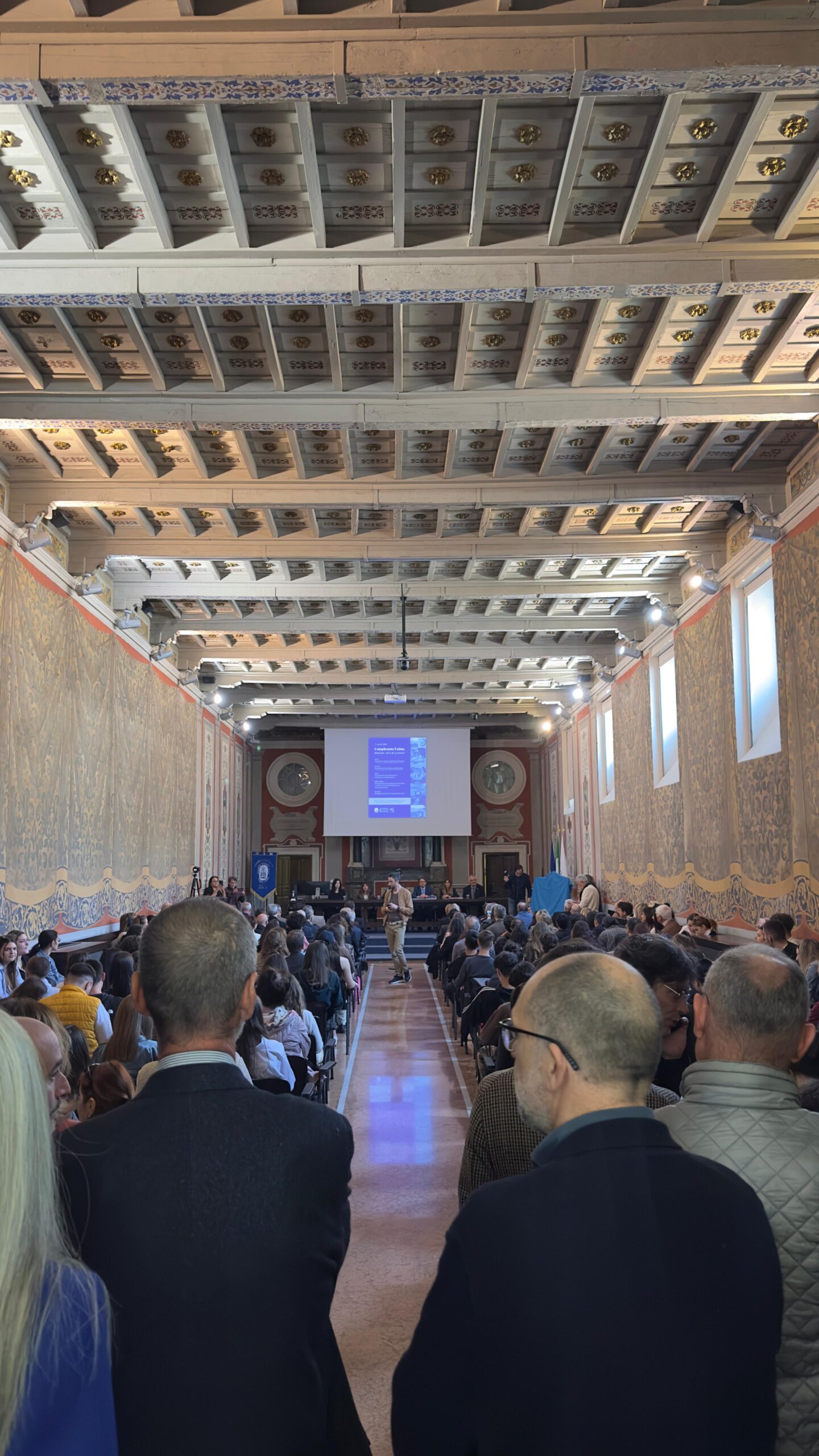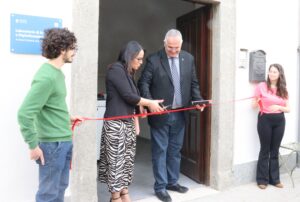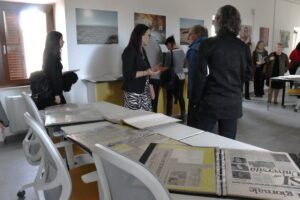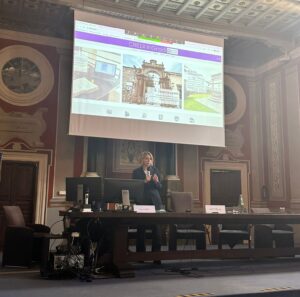


Art and objects must come out of museums and cultural digitization gives this possibility: universities and museums must network, I hope collaboration in this direction between universities and the Ministry of Culture will even be regulated.” With these words Massimo Osanna, director general of Museums of the Ministry of Culture, captured the meaning of CREDI In Gradi, a project aimed at promoting the protection, conservation, restoration, fruition, enhancement and digitization of the tangible and intangible cultural heritage of the monumental complex of Santa Maria in Gradi, home of the University of Tuscia. This research program, funded by the Ministry of Culture as part of the Culture Fund 2021, was presented this morning at the Rectorate, on the occasion of the launch of the initiatives for the 45th year since the founding of the University of Viterbo. Present at the event, in addition to Osanna, were the Magnificent Rector Stefano Ubertini; the director general of Archives of the Ministry of Culture, Antonio Tarasco; Federica Cerroni of the Soprintendenza archeologia, belle arti e paesaggio dell’Etruria Meridionale; and Monica Cavalletti, manager of the “Francesco Orioli” institute. At the end of the presentation, the Unitus Archives and Digitization Laboratory, directed by Gilda Nicolai, was inaugurated.
“I am very proud to have participated in the Ministry’s call for proposals with the CREDI In Gradi project,” Rector Ubertini went on to explain, “which attracted 1 million euros in funding, 250,000 of which were Unitus funds. I am proud of this because this research program united multiple departments and faculty from different disciplines, including ten women. This was not a call dedicated to universities, in fact only four Italian universities were funded, and this makes us even more proud.”
“I dream of an ideal place where the teaching of cultural heritage is not separated from work in the field,” said Antonio Tarasco. “Here at Unitus you fully grasp this spirit thanks to the digitization of the archives of the university’s historical structures carried out in this important project.
 Federica Cerroni, then, illustrated the restoration project of the Church of Santa Maria in Gradi, emphasizing “the collaboration between the Superintendence, Unitus and the Ministry of Culture not only on the Gradi complex,” she said, “but also for other historical sites of the athenaeum, with the involvement in such programs also of students for educational activities, even outside the athenaeum, as in the case of Ferento. “The projects carried out by high school art students for CREDI In Gradi,” added Dean Cavalletti, “have a spirit of sustainability as well as art, precisely to keep up with the world around us.
Federica Cerroni, then, illustrated the restoration project of the Church of Santa Maria in Gradi, emphasizing “the collaboration between the Superintendence, Unitus and the Ministry of Culture not only on the Gradi complex,” she said, “but also for other historical sites of the athenaeum, with the involvement in such programs also of students for educational activities, even outside the athenaeum, as in the case of Ferento. “The projects carried out by high school art students for CREDI In Gradi,” added Dean Cavalletti, “have a spirit of sustainability as well as art, precisely to keep up with the world around us.
CREDI In Gradi, a research program held over the two-year period 2021-2023, is coordinated by Ilaria Baffo, and the results were released this morning, illustrated by the team that oversaw the different areas of research.
Andrea Colantoni, Eva Ponzi and Vera Anelli, for the WP2 AR pathway, presented the part related to augmented reality, the virtual tour created with avatars activated through qr-codes found in the totems at the entrance of Unitus, in the cloisters and in the university museum system, within which one can find virtual avatars even of animals (cartoons) that accompany the visitor along the path.
For the WP3 HMI-Raman pathway, Claudia Pelosi and Ines Delfino focused on the characterization of the materials of the Santa Maria in Gradi heritage, carried out with the most up-to-date diagnostic approach to the cultural heritage, through the sophisticated and accurate HMI (multispectral analysis system that, through advanced image processing software, allows to obtain colorimetric and radiometric information from the acquired images with high precision) and Raman (spectroscopy based on inelastic light scattering, which allows to obtain information on molecular vibrations and to identify the components of the sample) technologies.
For path WP4 Biblio, Paolo Marini explained the digitization process of paper volumes belonging to the University Library System’s valuable library holdings, with the digital acquisition of a corpus of about 370 volumes published between the 16th and 20th centuries, selected according to a criterion of antiquity and rarity of the edition: 27 sixteenth-century; 22 seventeenth-century; 43 eighteenth-century; 47 nineteenth-century (pre-1831); other nineteenth- and twentieth-century volumes of particular value (including the complete collection of the journal “Primato”). These acquisitions were made in jpeg formats and are downloadable in pdf.
 Gilda Nicolai and Cristina Ricci explained WP5 Archi_Lab, the archival and digitization laboratory, and WP7 Archi_Tec, the university archive. “We have purchased the synapse software and a planetary scanner and a rotary scanner to acquire and digitize both books and works and objects as small as coins,” said Nicolai. “Today the digital archival lab will be inaugurated, which will be available to students for teaching purposes, but also for consultation through the crediingradi.it website. Ricci then went on to explain how the premises that house the laboratory and archives were recovered and renovated.
Gilda Nicolai and Cristina Ricci explained WP5 Archi_Lab, the archival and digitization laboratory, and WP7 Archi_Tec, the university archive. “We have purchased the synapse software and a planetary scanner and a rotary scanner to acquire and digitize both books and works and objects as small as coins,” said Nicolai. “Today the digital archival lab will be inaugurated, which will be available to students for teaching purposes, but also for consultation through the crediingradi.it website. Ricci then went on to explain how the premises that house the laboratory and archives were recovered and renovated.
For path WP6 EcoD Luisa Carbone, Elena Kuzminsky and Mariagrazia Agrimi illustrated multimedia ecodesign installations, including innovative technologies such as human interface GIS, storytelling, gamification, voicemap as a cultural connector of the urban landscape of Viterbo in the monumental complex of Santa Maria in Gradi. These installations were designed and created by students of the “Orioli” art high school in Viterbo with environmentally friendly materials, fully respecting the style of the complex and the visual identity of Unitus, and are meant to be enjoyed by visitors. “They are for the whole city of Viterbo,” Carbone emphasized, “not only for students, so everyone is invited to visit us.
 In the last speech, that of Chiara Moroni for WP8 Com, the communication activities, through dissemination and storytelling, used to tell and promote CREDI In Gradi and the cultural heritage of the university were illustrated. The communication action was aimed at bringing out otherwise hidden heritages and offers experiences of fruition, pursuing the innovative goal of sharing the experience of storytelling with citizens, local cultural organizations and associations, schools and other centers of dissemination and popularization of cultural and artistic heritage. An experience that is not only descriptive of the heritage, but that solicits and integrates the link between environments and local culture, perception and historical-traditional fruition of the asset and places. In this way, the richness and cultural value of the Santa Maria in Gradi complex is enhanced through the experiential dimension and the “appropriation” of another perception than the daily fruition of places. The new perception is built on knowledge and memory shared from below and experienced through different forms of storytelling. Citizens, students and community were reached through dedicated website, social, press office, seminars and conferences, descriptive videos. For this activity, Unitus partnered with experienced professionals in the field such as Studio Iandiorio, SkylabStudios and architect Alessio Patalocco.
In the last speech, that of Chiara Moroni for WP8 Com, the communication activities, through dissemination and storytelling, used to tell and promote CREDI In Gradi and the cultural heritage of the university were illustrated. The communication action was aimed at bringing out otherwise hidden heritages and offers experiences of fruition, pursuing the innovative goal of sharing the experience of storytelling with citizens, local cultural organizations and associations, schools and other centers of dissemination and popularization of cultural and artistic heritage. An experience that is not only descriptive of the heritage, but that solicits and integrates the link between environments and local culture, perception and historical-traditional fruition of the asset and places. In this way, the richness and cultural value of the Santa Maria in Gradi complex is enhanced through the experiential dimension and the “appropriation” of another perception than the daily fruition of places. The new perception is built on knowledge and memory shared from below and experienced through different forms of storytelling. Citizens, students and community were reached through dedicated website, social, press office, seminars and conferences, descriptive videos. For this activity, Unitus partnered with experienced professionals in the field such as Studio Iandiorio, SkylabStudios and architect Alessio Patalocco.
Viterbo, april 11th 2024